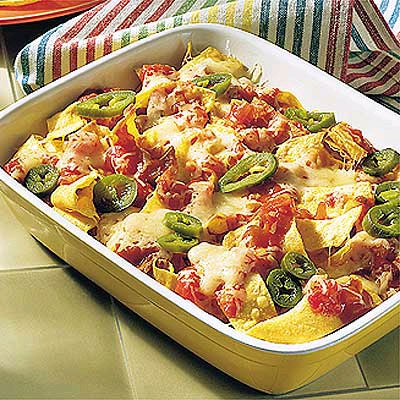

Mexican gastronomy enjoys international reputation. There are a wide variety of dishes from all over Mexico, and each region has many specialties, some of them are very exotic. It is important to know that not all dishes are spicy. Chiles (hot peppers) play a very important role in local cooking, and they are used everywhere in sauces. There are more than 200 different kinds of chilies, ranging from mild to extremely hot.
Numerous natural ingredients which are enjoyed worldwide have their origins in Mexico: foods such as corn, tomatoes, avocados, chocolate, beans, nopal, vanilla, squash, turkey, peanuts, and fresh fruits such as papaya, jicama, and guava. These ingredients have been used since prehispanic times, and all of them have become the mainstay of the most celebrated cuisine.
Corn was sacred in many pre-Columbian cultures. The most important use of corn was, and still is, making cornmeal dough for "tortilla". The way they used to prepare the dough is more or less the same today as during prehispanic times.The only difference is that in ancient times stone mortars and pestles were used whereas today, the process has been mechanized.
According to the region, tortillas can vary in color depending on the way the grain is cooked. They can be blue, yellow or red. Tortillas can also be different sizes, from two inches in diameter to a foot wide. Tortillas are the base for other typical Mexican dishes such as "enchiladas", with red or green sauce, and of course the famous "taco", the most popular being "tacos sudados", "Tacos al pastor", or "flautas".


Since the country spans several climatic zones, the types of foodstuffs vary greatly from region to region. To mention some of the most acclaimed Mexican dishes that feature complex ingredients and preparation techniques, we should start with the delicious soups such as: Azteca soup, tortilla soup, bean soup, seafood soup, and cream of "flor de calabaza"; and follow up with the famous "mole". There are different kind of moles, some of the most renown being mole from Puebla and the seven different kinds of moles of Oaxaca, including "mole negro", with more than 40 ingredients. There are also "chiles en nogada", "pozole", "cochinita pibil", "birria", "mixiote", "cecina", "cabrito", "machaca", "chilorio", and "barbacoa". There are also other dishes with exotic ingredients like "cuitlacoche", "jumiles", and "escamoles", just to mention a few. Mexican food is truly a fiesta.


The same cornmeal dough is also the basis for several popular dishes, such as "tamales", "atole", "gorditas", "tlacoyos", "chalupas", "guaraches", "sopes", and "antojitos" or Mexican savories.
Eggs served as "huevos rancheros", "huevos a la mexicana", "huevos con chorizo", or "huevos motulenos" as in the Yucatan region, other typical dish for breakfast is "chilaquiles".
Mexico has one of the finest selections of beers in the world with its many kinds and flavors. The tradition stems from the pre-Columbian era when they used to drink a beverage very similar to beer. When the conquerors arrived they brought with them their knowledge and started beer production in 1554. Since then the industry has grown steadily and today it has become one of the most important in the country. Beer is divided in two major categories: light, and dark, and there are many brand names. There is also the very popular way of drinking the beer, the famous "michelada", a refreshing drink of beer mixed with lime juice and served with salt on the rim of the glass.


The other famous Mexican drink is, of course, tequila. The best tequila is the one made of 100 percent blue agave, although there are others made of a blend of agave and sugar cane. There are different kinds of tequilas: "reposado" that are aged at least two months, "anejo", that have mellow brandy-like qualities and are aged minimum 12 months and the white tequilas, stronger than the former two. Tequila is usually served along with a "sangrita" in a clear, tall shot glass or in a miniature cognac snifter. Internationally, tequila is also served in cocktails, like the famous margarita, or the tequila sunrise.
Some other regions have their own distilled spirits. Mezcal, is produced mostly in the State of Oaxaca and it is made from another variety of agave, called Espadin. It is clear like the white tequila, but with a strong smoky scent and flavor derived from the roasting process or burning of mesquite and oak logs. The bottles sometimes contain a maguey worm.


In reference to fresh local drinks, it must be mentioned that Mexico has an abundance of juice bars in most resort towns, and freshly squeezed fruit juices are usually very good and inexpensive. Also good are the "licuados", a blend of fruit juice plus milk or water and ice buzzed in a blender, and of course the "aguas frescas", water with native flowers or fruits such as the "jamaica" and "tamarindo", or the famous "horchata".
Although desserts aren't the most prominent part of Mexican cuisine, there are some really appealing ones such as "flan", "crepas de cajeta", "ates" served with fresh cheese, "arroz con leche", "natillas" and "chongos". In latter years, the strong influence of the European cooking know-how mixed with native ingredients has resulted in delightful combinations, such as light mousses made of mango, mamey, or guanabana exotic fruits.